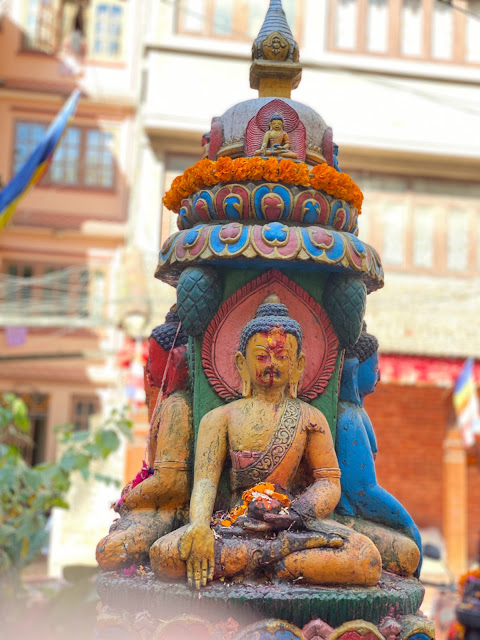Ci: Ba Dya ( चि : बा द्य्य ) and its Significance in Nepal
Facebook: Jhigu Nepa | Instagram: jhigunepa | E-mail: jhigunepa@gmail.com
‘Ci: Ba Dya’ (चि:बा द्य्य), Maru Khyokeba Tole, Kathmandu. Nov 10, 2021
If you've been to Kathmandu Valley, you've probably seen the captivating stone statue featuring four Buddhas facing different directions. You might wonder what it symbolizes.
This stone structure is known as ‘Ci: Ba Dya’ (चि:बा द्य्य) in Nepal Bhasa. You will mostly find this statute placed in the center of the courtyard throughout the ancient places of Kathmandu Valley, that were once, heavily populated by the Newars. This structure not only holds spiritual significance but also underscores the deep-rooted Buddhist devotion of the Newars. On this stone statue, you will find four Buddhas sitting in various mudras facing four directions, including the one which is placed inside the womb of the statue. This is the representation of Pancha Buddha, self emanated in Kathmandu Valley.
Notably, at the world's oldest Buddhist pilgrimage, Swayambhu, similar structure of five Buddhas are positioned in different directions around the Swayambhu Maha Chaitya, further exemplifying its significance and the spiritual tradition.
As stated in Swayambhu Purana, many eons ago Kathmandu Valley was a giant lake where Bipashwi Buddha came to take a dip into this beautiful lake. He is said to have thrown a lotus seed into the lake which eventually led to the blooming of thousand petalled lotus over which appeared the self-originated rays of five different colors: white, yellow, green, red and blue which we worship as the Pancha Buddha, popularly referred as the Five Dhyani Buddhas in the West.
Who are the Pancha Buddha ?
Now, you may wonder who these Five Buddhas are and what the colors represent. Here, I will briefly describe these Five Buddhas and their significance. Each Dhyani Buddha is associated with distinct attributes: a designated color, a specific mudra (hand gesture), a sacred symbol, and a symbolic animal for their seat. These connections hold significant symbolism in Vajrayana Buddhism.
- Vairocana ((वैरोचन) Buddha- Vairocana Buddha is represented in white color, holds his hands in the Dharmachakra mudra. The thumbs and index fingers touch at the tips to form a wheel, symbolizing the turning of the wheel of Dharma. This gesture signifies teaching and overcoming ignorance and delusion. Vairocana is traditionally seated inside the womb of the Chaitya, making him invisible in the external structure.
- Akshobhya (अक्षोभ्य) Buddha - He is blue in color and faces the East. His hand gesture is the Bhumisparsha (earth-touching) mudra. After attaining enlightenment, when questioned by Mara (the lord of desire) for evidence of his enlightenment, Buddha touched the earth, declaring it as his witness.
- Amitabha Buddha- He is red in color sitting in Dhyan (meditation) mudra and faces East (पुर्व) direction. He is the most widely worshipped amongst the Pancha Buddha by Newa Buddhists community.
- Amoghasiddhi (अमोघसिद्धी) Buddha- He faces North (उत्तर) direction and green in color, sits in Abhaya
(fearless) mudra with the seven snakes over his head.
- Ratnasambhava (रत्त्नसंभव) Buddha- He faces South (दक्षिण) direction and yellow in color, sits in Varada (वरदा) mudra.
Placement of Pancha Buddha in Dharmadhatu Mandal
Unlike all other Buddhas (Shakyamuni Buddha. Dipankar Buddha,
Sikhi Buddha, etc.), these five Buddhas did not take birth on this earth in a
human form and attain enlightenment. They are regarded as Primordial Buddha, a representation
of life, universe, five elements, five sensations, five colors, five wisdoms, etc. They
are regarded as the means to attain Buddha-hood. Along with Shakyamuni Gautam Buddha, all his predecessors have attained the five wisdom that are possessed by
these Primordial Buddha which is known as Bodhi Gyan. That is the ultimate wisdom each Samyak Sambodhi Buddhas have attained and preached during their lifetime.
- Dr. Kabindra Bajracharya, a Buddhist Scholar. Associate professor, Cataract & PHACO Surgeon, Consultant Pediatric Ophthalmologist, Outreach Director at Lumbini Eye Institute.
- Prakash Man Sakwo, a scholar and historian from Sakwo (known as Sankhu, today). An author of multiple books on the culture, religion and festivals of Newars.
- श्री स्वयम्भु महाचैत्य , " स्वयम्भु महाचैत्य स्थान्य राजा धर्मदेवया धर्मशाला निर्माण " - हेम राज शाक्य |









Very nicely written ,easy to understand and informative. Thanks You
ReplyDelete